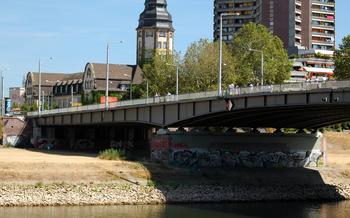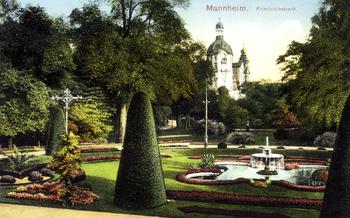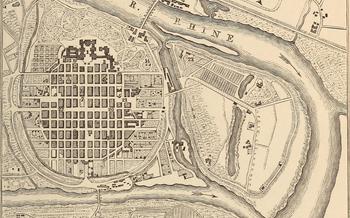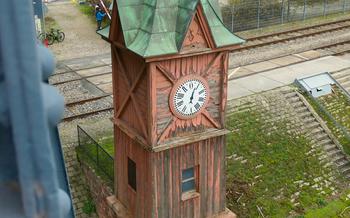
Mannheim Palace (Mannheimer Schloss)
- Mannheim Palace: A Baroque Masterpiece in the Heart of the City
- Exploring the Palace Grounds: A Haven of Tranquility
- The Grand Courtyard: A Showcase of Architectural Elegance
- The Palace's Interior: A Journey Through History
- The Electoral Chapel: A Spiritual Haven
- The Gemäldegalerie: A Masterful Display of Art
- The Reiss-Engelhorn-Museen: A Multifaceted Cultural Complex
- The Schillerdenkmal: Honoring a Literary Legend
- The Wasserturm: An Architectural Landmark
- The Rosengarten: A Fragrant Oasis in the City
- The Mannheim Baroque Orchestra: A Musical Legacy
- Insider Tip: The Secret Garden
Mannheim Palace: A Baroque Masterpiece in the Heart of the City
The Mannheim Palace, also known as the Mannheimer Schloss, stands as a testament to the grandeur and opulence of the Baroque era. Once the magnificent residence of the Electors of the Palatinate, this architectural masterpiece has played a pivotal role in shaping the city's identity and history. Its impressive facade, adorned with intricate carvings and sculptures, reflects the refined tastes and artistic prowess of the 18th century.
The palace's construction began in 1720 under the patronage of Elector Carl Philipp, who envisioned a grand palace befitting his status and power. Renowned architects and artisans were commissioned to bring his vision to life, resulting in a harmonious blend of Baroque and Rococo styles. The palace's imposing presence dominates the city center, serving as a prominent landmark and a symbol of Mannheim's rich cultural heritage.
Exploring the Palace Grounds: A Haven of Tranquility
The Mannheim Palace is surrounded by beautifully landscaped gardens, providing a serene oasis in the heart of the city. Visitors can wander through the meticulously manicured lawns, admire the vibrant flowerbeds, and soak in the tranquil atmosphere. Notable features include ornate sculptures, cascading fountains, and a picturesque pond that adds to the charm of the garden. Whether you're seeking a leisurely stroll, a moment of relaxation, or simply a chance to appreciate the natural beauty, the palace gardens offer a delightful retreat from the bustling city.
The Grand Courtyard: A Showcase of Architectural Elegance
The grand courtyard of Mannheim Palace is a testament to the architectural brilliance and grandeur of the Baroque era. Its impressive size and scale create a sense of awe and wonder as visitors step into this expansive space. The courtyard is surrounded by three wings of the palace, each featuring intricate ornamentation, graceful arches, and elegant columns that harmonize to create a cohesive and visually stunning ensemble.
The arcades that line the courtyard provide a covered walkway, allowing visitors to stroll leisurely while admiring the architectural details. The columns that support the arcades add a touch of majesty and elegance to the space, their fluted surfaces and elaborate capitals drawing the eye upward. The courtyard's focal point is the central fountain, a symbol of opulence and refinement. Its cascading waters create a soothing ambiance, adding a touch of serenity to the grand surroundings.
The grand courtyard has served as a venue for various events and cultural performances throughout history. Its spaciousness and versatility have made it an ideal setting for concerts, theatrical productions, and festivals. The courtyard's acoustics are particularly well-suited for musical performances, allowing the sounds to reverberate and fill the air with enchanting melodies.
The Palace's Interior: A Journey Through History
The interior of the Mannheim Palace is a testament to the opulence and grandeur of the Baroque era. Visitors are greeted by a grand entrance hall, adorned with intricate carvings, opulent chandeliers, and sweeping staircases. The palace's numerous rooms and halls each have their own unique features and historical significance.
The Throne Room, once the seat of power for the Electors of the Palatinate, is a particularly impressive sight. The room is dominated by an elaborate throne, flanked by ornate tapestries and paintings depicting scenes from the Electoral Court. The Mirror Room, with its walls lined with mirrors and sparkling chandeliers, reflects the opulence of the Electoral lifestyle.
The palace also houses several other notable rooms, such as the Council Chamber, where important decisions were made, and the Banquet Hall, where lavish feasts were held. These rooms provide a glimpse into the daily lives of the Electors and their court.
In the 19th century, the palace underwent a transformation, becoming a museum dedicated to the city's rich history. Today, visitors can explore the palace's interior and learn about its former inhabitants, while admiring the many works of art and historical artifacts on display.
The Electoral Chapel: A Spiritual Haven
Within the grand complex of the Mannheim Palace, the Electoral Chapel stands as a testament to the Electors' deep religious devotion. Designed by renowned architect Alessandro Galli Bibiena, this Baroque masterpiece captivates visitors with its ornate facade, intricate stucco work, and soaring dome. Step inside to discover a sanctuary of spiritual tranquility, where the air is filled with the echoes of centuries past.
The chapel's interior is adorned with exquisite frescoes depicting biblical scenes and the lives of saints, creating a visually stunning and awe-inspiring atmosphere. The centerpiece of the chapel is the magnificent high altar, a testament to the skill and artistry of the Baroque era. Intricate carvings, delicate gilding, and vibrant colors combine to create a focal point that draws the eye upward.
The Electoral Chapel was not just a place of worship for the Electors and their court; it also played a significant role in the religious life of Mannheim. Here, the Electors would attend Mass, celebrate important religious festivals, and seek spiritual guidance. The chapel's grandeur and opulence reflected the Electors' deep faith and their desire to create a sacred space that would inspire and uplift the spirits of all who entered.
The Gemäldegalerie: A Masterful Display of Art
The Gemäldegalerie within the Mannheim Palace is a treasure trove of artistic masterpieces, inviting visitors to embark on a journey through the history of art. The gallery's diverse collection spans various eras and artistic movements, showcasing works by renowned artists such as Rembrandt, Rubens, and Monet.
Visitors can admire the vibrant colors and intricate brushstrokes of Rembrandt's captivating portraits, capturing the essence of his subjects with remarkable realism. The gallery also boasts a collection of Rubens' dynamic and Baroque paintings, characterized by their opulent compositions and energetic brushwork.
Among the highlights of the Gemäldegalerie is a stunning collection of Impressionist paintings, including several works by Claude Monet. These evocative landscapes and scenes capture the fleeting beauty of nature, inviting viewers to immerse themselves in the Impressionist world of light and color.
Thematic exhibitions and temporary displays enrich the gallery's offerings, providing visitors with a fresh perspective on art history. These exhibitions often focus on specific artists, movements, or themes, showcasing hidden gems from the collection and shedding light on the evolution of artistic expression.
Whether you are an art enthusiast or simply appreciate the beauty of great paintings, the Gemäldegalerie at the Mannheim Palace is a must-visit destination. Immerse yourself in the world of art and discover the masterpieces that have shaped the course of artistic history.
The Reiss-Engelhorn-Museen: A Multifaceted Cultural Complex
Just a short walk from the Mannheim Palace, the Reiss-Engelhorn-Museen offers a captivating journey through history, nature, and art. This multifaceted cultural complex comprises a diverse array of museums, each showcasing unique and fascinating collections.
Natural History Museum: Immerse yourself in the wonders of the natural world through captivating exhibits showcasing fossils, minerals, and wildlife specimens. Discover the diversity of life on Earth and gain insight into the intricate workings of ecosystems.
Archaeological Museum: Unearth the secrets of ancient civilizations as you explore the Archaeological Museum. Marvel at artifacts from prehistoric settlements, Roman ruins, and medieval excavations, offering a glimpse into the rich cultural heritage of the region.
Art Museum: Embark on an artistic adventure at the Art Museum, where you'll find a treasure trove of paintings, sculptures, and decorative arts spanning various eras and styles. From Renaissance masterpieces to contemporary creations, the museum offers a visual feast for art enthusiasts.
Whether you're passionate about history, nature, or art, the Reiss-Engelhorn-Museen promises an enriching and engaging experience. Take advantage of the proximity to the Mannheim Palace and delve into the cultural tapestry of this vibrant city.
The Schillerdenkmal: Honoring a Literary Legend
Amidst the grandeur of the Mannheim Palace's grounds, one finds a poignant tribute to a literary icon: the Schillerdenkmal. This monument, majestically situated, stands as a testament to the enduring legacy of Friedrich Schiller, one of Germany's most celebrated poets, playwrights, and philosophers.
The Schillerdenkmal, unveiled in 1862, is a masterpiece of neoclassical artistry. Conceived by the renowned sculptor Ernst Rietschel, the monument depicts Schiller in a moment of profound contemplation, his gaze seemingly lost in the depths of inspiration. The bronze figure, poised atop a granite pedestal, exudes an aura of intellectual depth and creative genius.
The monument's intricate symbolism further enhances its significance. Schiller is portrayed holding a quill in one hand, symbolizing his literary prowess, while the other hand rests upon a lyre, representing the harmonious union of poetry and music. The pedestal is adorned with allegorical figures representing Schiller's major works, including "Wilhelm Tell," "Maria Stuart," and "Wallenstein."
The Schillerdenkmal not only celebrates the life and achievements of a literary giant but also serves as a reminder of Mannheim's rich cultural heritage. Schiller's profound connection to the city, where he lived and worked for several years, is deeply embedded in the monument's presence within the palace grounds.
Visitors to the Mannheim Palace are encouraged to pay homage to the great poet by pausing at the Schillerdenkmal. Here, amidst the splendor of the Baroque masterpiece, one can reflect upon the enduring power of art, the transformative nature of literature, and the legacy of a visionary who continues to inspire generations.
The Wasserturm: An Architectural Landmark
Amidst the grandeur of Mannheim Palace, the Wasserturm stands as a unique architectural landmark. Originally constructed in 1889 as a water tower, this impressive structure served the practical purpose of supplying water to the city. Today, the Wasserturm has undergone a remarkable transformation, emerging as a cultural venue that hosts a variety of events and exhibitions.
One of the key attractions of the Wasserturm is its panoramic viewing platform. Ascend the tower's winding staircase or take the convenient elevator to reach the top, where you will be rewarded with breathtaking views of Mannheim's cityscape. The surrounding gardens, the majestic Rhine River, and the distant hills create a picturesque panorama that is sure to captivate visitors.
In addition to its stunning views, the Wasserturm offers a diverse range of cultural experiences. The tower's versatile spaces host art exhibitions, photography displays, and historical presentations. It also serves as a venue for concerts, performances, and lectures, providing a platform for local and international artists to showcase their talents.
By combining its architectural heritage with a modern cultural purpose, the Wasserturm has become an integral part of Mannheim's vibrant arts scene. Whether you are drawn to its historical significance, its panoramic views, or its diverse cultural offerings, the Wasserturm is a must-visit destination for anyone exploring the city.
The Rosengarten: A Fragrant Oasis in the City
Adjacent to the palace grounds, the Rosengarten (Rose Garden) offers a tranquil escape from the urban bustle. Established in 1883, this enchanting garden is a fragrant oasis, home to over 11,000 roses, meticulously arranged in vibrant displays. Visitors can wander along winding paths, admiring the diverse varieties of roses, from classic red and white blooms to unique and exotic hybrids. The air is filled with a heady perfume, creating a sensory experience that delights the senses.
Beyond the roses, the Rosengarten boasts a variety of other flowers, including perennials, annuals, and seasonal blooms. The garden is designed with meticulous precision, featuring intricate flower beds, manicured lawns, and charming sculptures. Visitors can relax on benches amidst the colorful blooms, immersing themselves in the beauty of nature. The Rosengarten is a popular spot for locals and tourists alike, offering a serene retreat from the hustle and bustle of the city. It is a place to unwind, take a break from sightseeing, and simply enjoy the beauty of nature.
The Mannheim Baroque Orchestra: A Musical Legacy
Enrich your Mannheim experience with the melodious strains of the Mannheim Baroque Orchestra, a world-renowned ensemble dedicated to preserving and performing Baroque music. Deeply rooted in the city's rich musical heritage, the orchestra has a longstanding connection to the Mannheim Palace, where they frequently perform, gracing its halls with their virtuosic renditions of Baroque masterpieces.
Founded in 1980, the Mannheim Baroque Orchestra has garnered international acclaim for its exceptional musicianship and authentic interpretations. Comprised of talented musicians who share a passion for Baroque music, the orchestra strives to recreate the vibrant and expressive style that characterized this era.
Attending a concert by the Mannheim Baroque Orchestra is a unique and unforgettable experience. The orchestra's performances are marked by their energy, precision, and attention to detail, transporting audiences back in time to the grandeur of the Baroque era. The exquisite acoustics of the Mannheim Palace further enhance the musical experience, creating an immersive and intimate atmosphere.
Whether you are a seasoned classical music enthusiast or simply seeking a memorable cultural experience, the Mannheim Baroque Orchestra is not to be missed. Immerse yourself in the beauty of Baroque music, performed by one of the world's leading ensembles, within the walls of the historic Mannheim Palace.
Insider Tip: The Secret Garden
Beyond the grand halls and manicured gardens of the Mannheim Palace lies a hidden gem known as the Secret Garden. Shrouded in mystery and seclusion, this enchanting garden offers a tranquil escape from the bustling city.
To uncover this hidden treasure, visitors must venture through a discreet entrance, concealed among the palace's many corridors. Once inside, they are greeted by a serene oasis, where time seems to stand still. The garden is a testament to the palace's rich history, featuring ancient trees, vibrant flowers, and intricate sculptures that whisper tales of a bygone era.
In the heart of the Secret Garden lies a charming gazebo, inviting visitors to sit, relax, and immerse themselves in the tranquility of their surroundings. The gentle rustling of leaves and the sweet fragrance of blooming flowers create a symphony of nature, while the distant sounds of the city provide a subtle reminder of the bustling world beyond.
The Secret Garden is a place where visitors can escape the ordinary and reconnect with their inner selves. It is a place where history, nature, and beauty intertwine, creating a magical experience that will linger long after their visit.









